Assessing Sustainability Practices in the Nigerian Financial System
VerifiedAdded on 2022/11/28
|13
|2815
|494
Essay
AI Summary
This essay provides a comprehensive analysis of sustainability practices within the Nigerian financial system, with a specific focus on the role and initiatives of the Central Bank of Nigeria (CBN). The essay explores how the CBN integrates social, environmental, and governance criteria into traditional b...
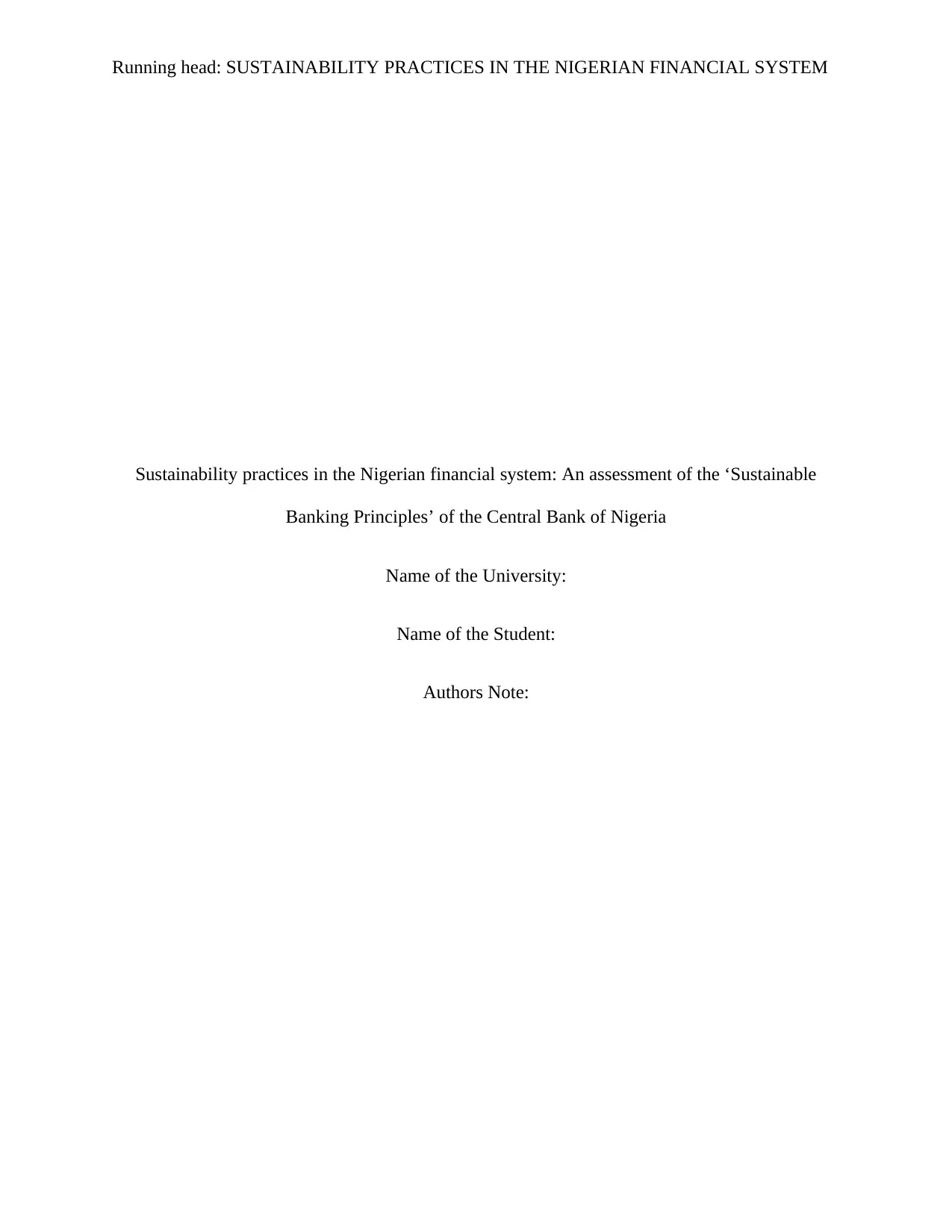
Running head: SUSTAINABILITY PRACTICES IN THE NIGERIAN FINANCIAL SYSTEM
Sustainability practices in the Nigerian financial system: An assessment of the ‘Sustainable
Banking Principles’ of the Central Bank of Nigeria
Name of the University:
Name of the Student:
Authors Note:
Sustainability practices in the Nigerian financial system: An assessment of the ‘Sustainable
Banking Principles’ of the Central Bank of Nigeria
Name of the University:
Name of the Student:
Authors Note:
Paraphrase This Document
Need a fresh take? Get an instant paraphrase of this document with our AI Paraphraser
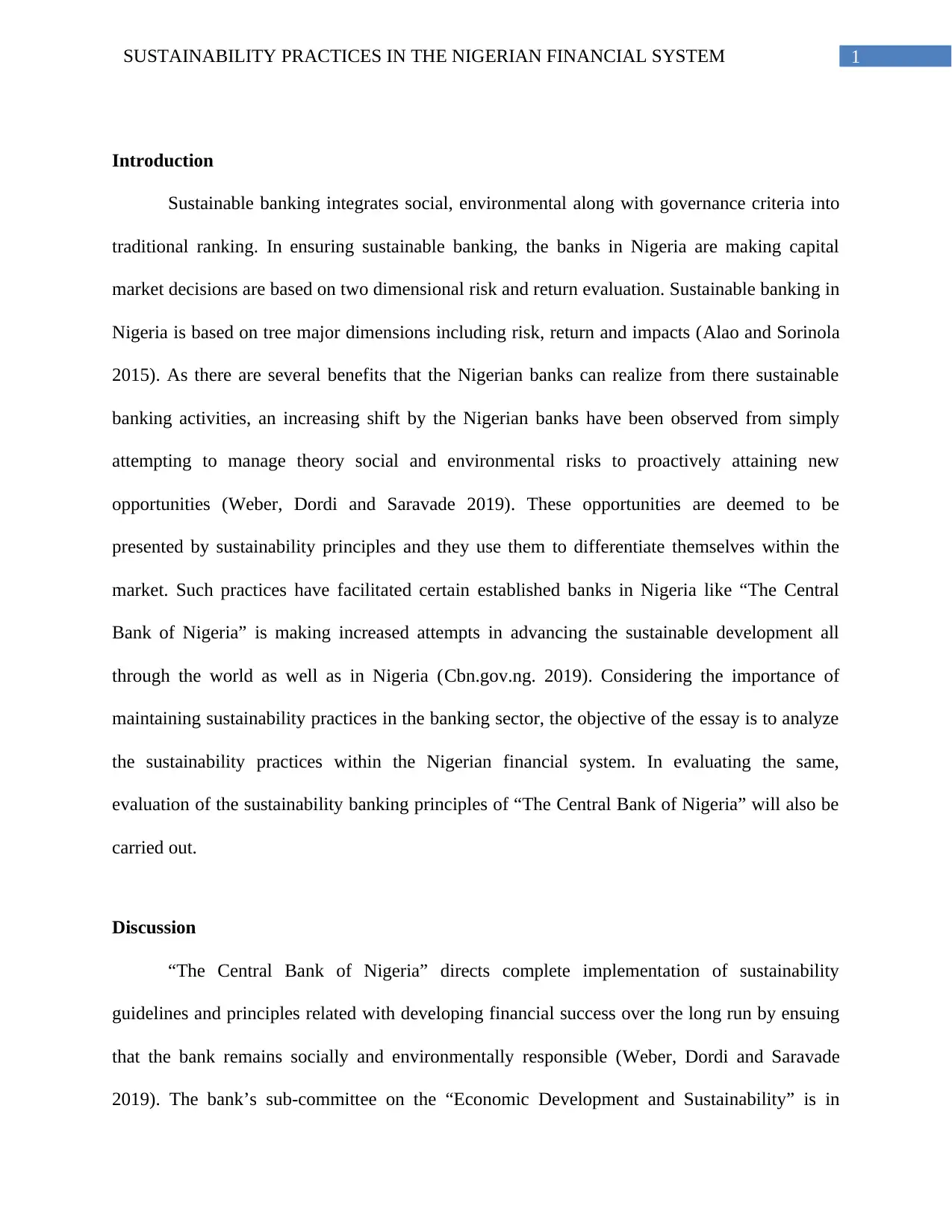
1SUSTAINABILITY PRACTICES IN THE NIGERIAN FINANCIAL SYSTEM
Introduction
Sustainable banking integrates social, environmental along with governance criteria into
traditional ranking. In ensuring sustainable banking, the banks in Nigeria are making capital
market decisions are based on two dimensional risk and return evaluation. Sustainable banking in
Nigeria is based on tree major dimensions including risk, return and impacts (Alao and Sorinola
2015). As there are several benefits that the Nigerian banks can realize from there sustainable
banking activities, an increasing shift by the Nigerian banks have been observed from simply
attempting to manage theory social and environmental risks to proactively attaining new
opportunities (Weber, Dordi and Saravade 2019). These opportunities are deemed to be
presented by sustainability principles and they use them to differentiate themselves within the
market. Such practices have facilitated certain established banks in Nigeria like “The Central
Bank of Nigeria” is making increased attempts in advancing the sustainable development all
through the world as well as in Nigeria (Cbn.gov.ng. 2019). Considering the importance of
maintaining sustainability practices in the banking sector, the objective of the essay is to analyze
the sustainability practices within the Nigerian financial system. In evaluating the same,
evaluation of the sustainability banking principles of “The Central Bank of Nigeria” will also be
carried out.
Discussion
“The Central Bank of Nigeria” directs complete implementation of sustainability
guidelines and principles related with developing financial success over the long run by ensuing
that the bank remains socially and environmentally responsible (Weber, Dordi and Saravade
2019). The bank’s sub-committee on the “Economic Development and Sustainability” is in
Introduction
Sustainable banking integrates social, environmental along with governance criteria into
traditional ranking. In ensuring sustainable banking, the banks in Nigeria are making capital
market decisions are based on two dimensional risk and return evaluation. Sustainable banking in
Nigeria is based on tree major dimensions including risk, return and impacts (Alao and Sorinola
2015). As there are several benefits that the Nigerian banks can realize from there sustainable
banking activities, an increasing shift by the Nigerian banks have been observed from simply
attempting to manage theory social and environmental risks to proactively attaining new
opportunities (Weber, Dordi and Saravade 2019). These opportunities are deemed to be
presented by sustainability principles and they use them to differentiate themselves within the
market. Such practices have facilitated certain established banks in Nigeria like “The Central
Bank of Nigeria” is making increased attempts in advancing the sustainable development all
through the world as well as in Nigeria (Cbn.gov.ng. 2019). Considering the importance of
maintaining sustainability practices in the banking sector, the objective of the essay is to analyze
the sustainability practices within the Nigerian financial system. In evaluating the same,
evaluation of the sustainability banking principles of “The Central Bank of Nigeria” will also be
carried out.
Discussion
“The Central Bank of Nigeria” directs complete implementation of sustainability
guidelines and principles related with developing financial success over the long run by ensuing
that the bank remains socially and environmentally responsible (Weber, Dordi and Saravade
2019). The bank’s sub-committee on the “Economic Development and Sustainability” is in
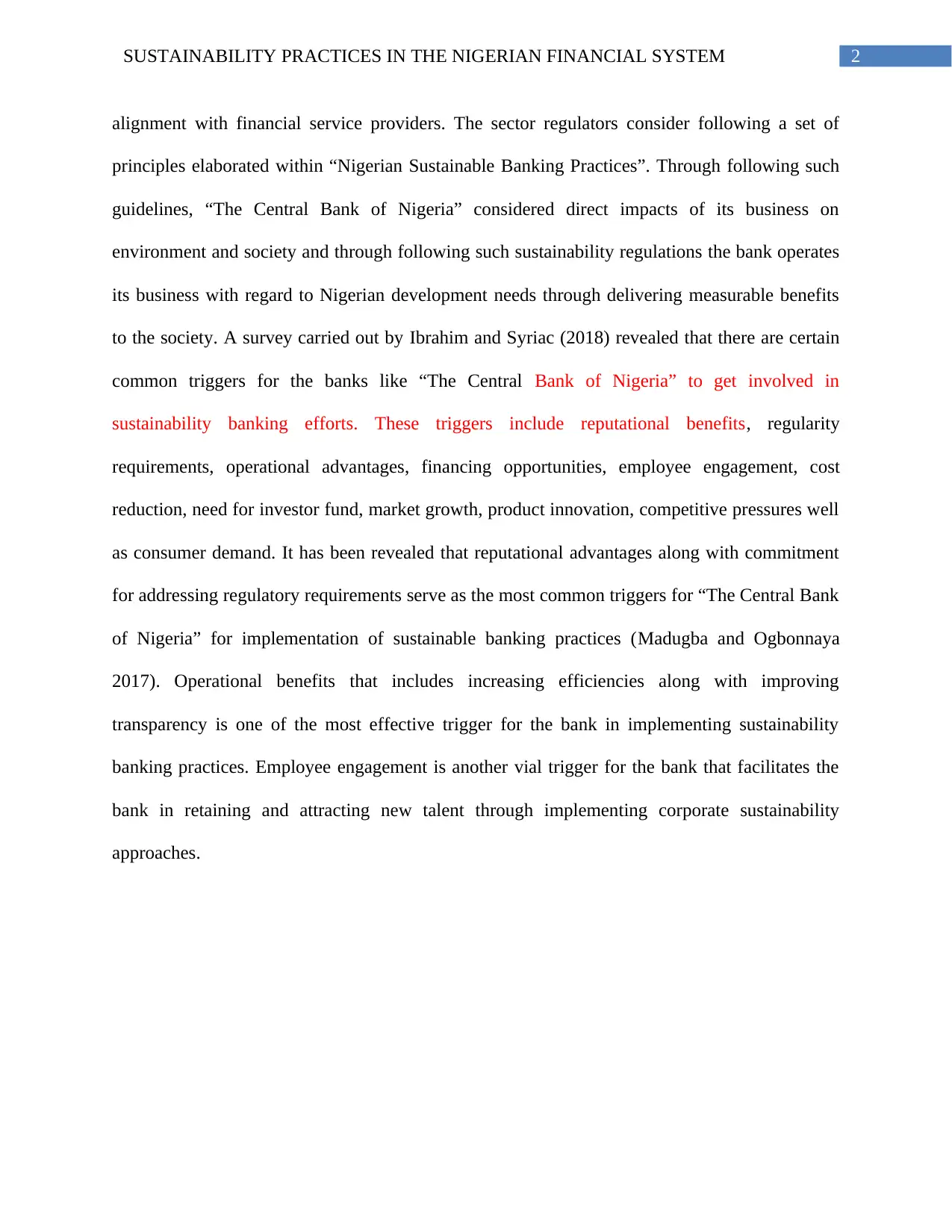
2SUSTAINABILITY PRACTICES IN THE NIGERIAN FINANCIAL SYSTEM
alignment with financial service providers. The sector regulators consider following a set of
principles elaborated within “Nigerian Sustainable Banking Practices”. Through following such
guidelines, “The Central Bank of Nigeria” considered direct impacts of its business on
environment and society and through following such sustainability regulations the bank operates
its business with regard to Nigerian development needs through delivering measurable benefits
to the society. A survey carried out by Ibrahim and Syriac (2018) revealed that there are certain
common triggers for the banks like “The Central Bank of Nigeria” to get involved in
sustainability banking efforts. These triggers include reputational benefits, regularity
requirements, operational advantages, financing opportunities, employee engagement, cost
reduction, need for investor fund, market growth, product innovation, competitive pressures well
as consumer demand. It has been revealed that reputational advantages along with commitment
for addressing regulatory requirements serve as the most common triggers for “The Central Bank
of Nigeria” for implementation of sustainable banking practices (Madugba and Ogbonnaya
2017). Operational benefits that includes increasing efficiencies along with improving
transparency is one of the most effective trigger for the bank in implementing sustainability
banking practices. Employee engagement is another vial trigger for the bank that facilitates the
bank in retaining and attracting new talent through implementing corporate sustainability
approaches.
alignment with financial service providers. The sector regulators consider following a set of
principles elaborated within “Nigerian Sustainable Banking Practices”. Through following such
guidelines, “The Central Bank of Nigeria” considered direct impacts of its business on
environment and society and through following such sustainability regulations the bank operates
its business with regard to Nigerian development needs through delivering measurable benefits
to the society. A survey carried out by Ibrahim and Syriac (2018) revealed that there are certain
common triggers for the banks like “The Central Bank of Nigeria” to get involved in
sustainability banking efforts. These triggers include reputational benefits, regularity
requirements, operational advantages, financing opportunities, employee engagement, cost
reduction, need for investor fund, market growth, product innovation, competitive pressures well
as consumer demand. It has been revealed that reputational advantages along with commitment
for addressing regulatory requirements serve as the most common triggers for “The Central Bank
of Nigeria” for implementation of sustainable banking practices (Madugba and Ogbonnaya
2017). Operational benefits that includes increasing efficiencies along with improving
transparency is one of the most effective trigger for the bank in implementing sustainability
banking practices. Employee engagement is another vial trigger for the bank that facilitates the
bank in retaining and attracting new talent through implementing corporate sustainability
approaches.
⊘ This is a preview!⊘
Do you want full access?
Subscribe today to unlock all pages.

Trusted by 1+ million students worldwide
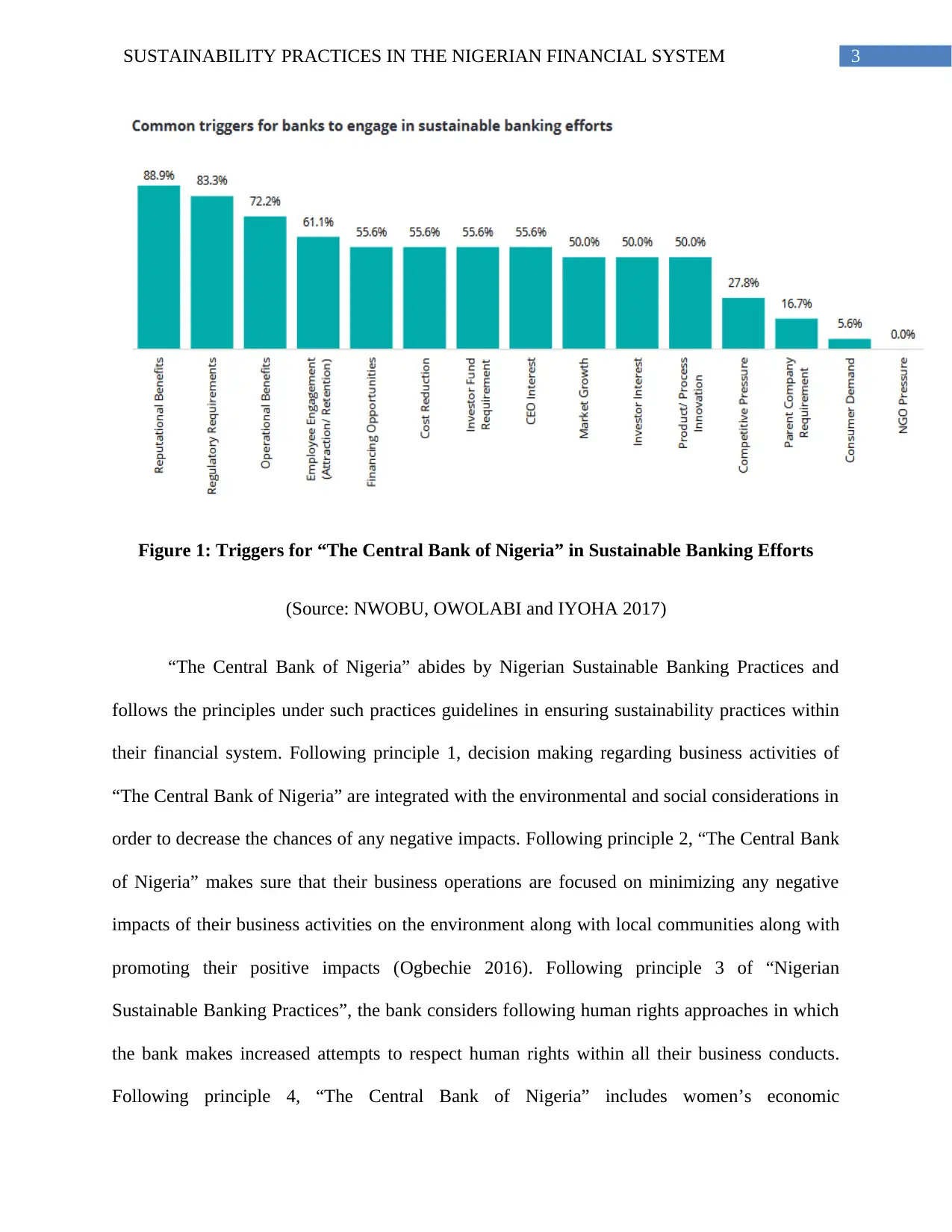
3SUSTAINABILITY PRACTICES IN THE NIGERIAN FINANCIAL SYSTEM
Figure 1: Triggers for “The Central Bank of Nigeria” in Sustainable Banking Efforts
(Source: NWOBU, OWOLABI and IYOHA 2017)
“The Central Bank of Nigeria” abides by Nigerian Sustainable Banking Practices and
follows the principles under such practices guidelines in ensuring sustainability practices within
their financial system. Following principle 1, decision making regarding business activities of
“The Central Bank of Nigeria” are integrated with the environmental and social considerations in
order to decrease the chances of any negative impacts. Following principle 2, “The Central Bank
of Nigeria” makes sure that their business operations are focused on minimizing any negative
impacts of their business activities on the environment along with local communities along with
promoting their positive impacts (Ogbechie 2016). Following principle 3 of “Nigerian
Sustainable Banking Practices”, the bank considers following human rights approaches in which
the bank makes increased attempts to respect human rights within all their business conducts.
Following principle 4, “The Central Bank of Nigeria” includes women’s economic
Figure 1: Triggers for “The Central Bank of Nigeria” in Sustainable Banking Efforts
(Source: NWOBU, OWOLABI and IYOHA 2017)
“The Central Bank of Nigeria” abides by Nigerian Sustainable Banking Practices and
follows the principles under such practices guidelines in ensuring sustainability practices within
their financial system. Following principle 1, decision making regarding business activities of
“The Central Bank of Nigeria” are integrated with the environmental and social considerations in
order to decrease the chances of any negative impacts. Following principle 2, “The Central Bank
of Nigeria” makes sure that their business operations are focused on minimizing any negative
impacts of their business activities on the environment along with local communities along with
promoting their positive impacts (Ogbechie 2016). Following principle 3 of “Nigerian
Sustainable Banking Practices”, the bank considers following human rights approaches in which
the bank makes increased attempts to respect human rights within all their business conducts.
Following principle 4, “The Central Bank of Nigeria” includes women’s economic
Paraphrase This Document
Need a fresh take? Get an instant paraphrase of this document with our AI Paraphraser
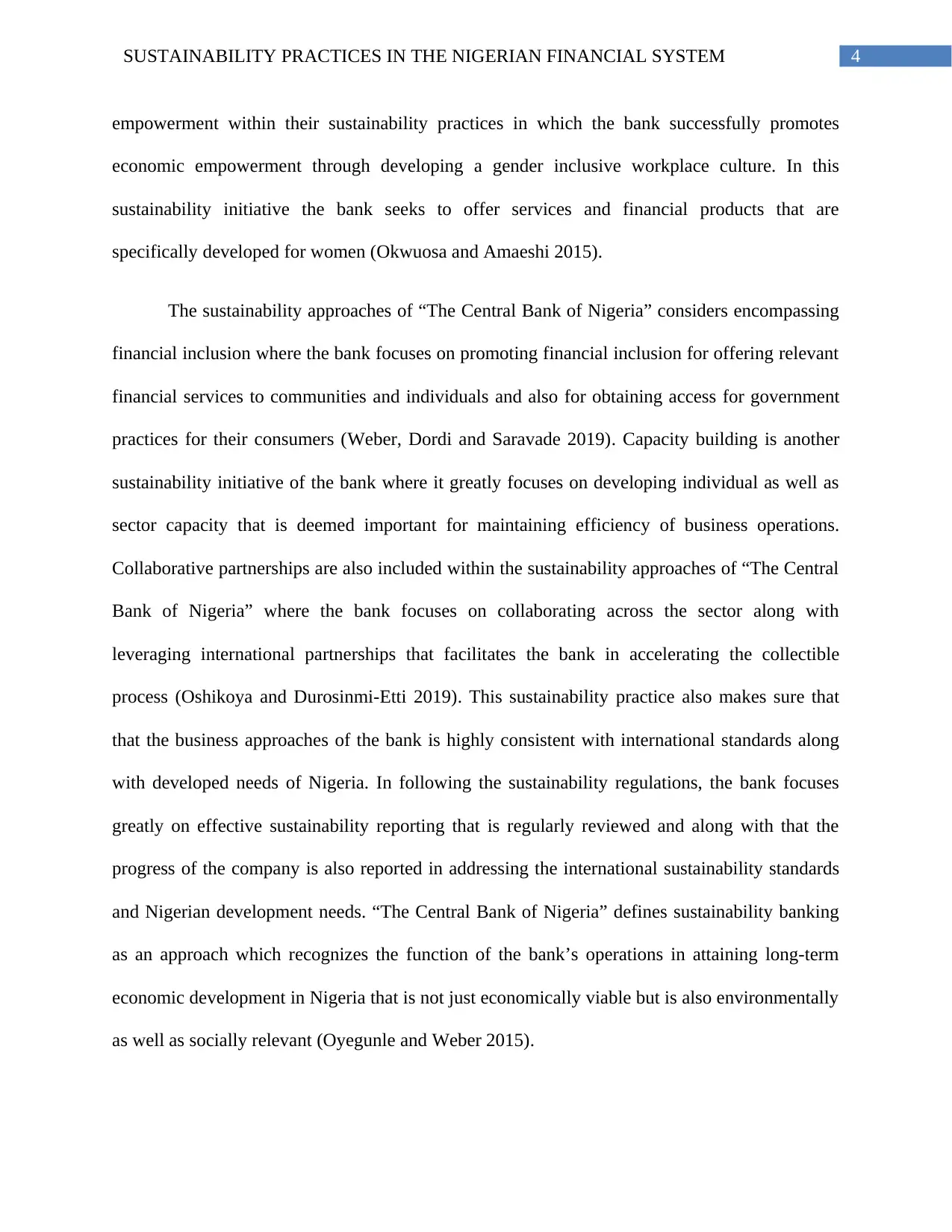
4SUSTAINABILITY PRACTICES IN THE NIGERIAN FINANCIAL SYSTEM
empowerment within their sustainability practices in which the bank successfully promotes
economic empowerment through developing a gender inclusive workplace culture. In this
sustainability initiative the bank seeks to offer services and financial products that are
specifically developed for women (Okwuosa and Amaeshi 2015).
The sustainability approaches of “The Central Bank of Nigeria” considers encompassing
financial inclusion where the bank focuses on promoting financial inclusion for offering relevant
financial services to communities and individuals and also for obtaining access for government
practices for their consumers (Weber, Dordi and Saravade 2019). Capacity building is another
sustainability initiative of the bank where it greatly focuses on developing individual as well as
sector capacity that is deemed important for maintaining efficiency of business operations.
Collaborative partnerships are also included within the sustainability approaches of “The Central
Bank of Nigeria” where the bank focuses on collaborating across the sector along with
leveraging international partnerships that facilitates the bank in accelerating the collectible
process (Oshikoya and Durosinmi-Etti 2019). This sustainability practice also makes sure that
that the business approaches of the bank is highly consistent with international standards along
with developed needs of Nigeria. In following the sustainability regulations, the bank focuses
greatly on effective sustainability reporting that is regularly reviewed and along with that the
progress of the company is also reported in addressing the international sustainability standards
and Nigerian development needs. “The Central Bank of Nigeria” defines sustainability banking
as an approach which recognizes the function of the bank’s operations in attaining long-term
economic development in Nigeria that is not just economically viable but is also environmentally
as well as socially relevant (Oyegunle and Weber 2015).
empowerment within their sustainability practices in which the bank successfully promotes
economic empowerment through developing a gender inclusive workplace culture. In this
sustainability initiative the bank seeks to offer services and financial products that are
specifically developed for women (Okwuosa and Amaeshi 2015).
The sustainability approaches of “The Central Bank of Nigeria” considers encompassing
financial inclusion where the bank focuses on promoting financial inclusion for offering relevant
financial services to communities and individuals and also for obtaining access for government
practices for their consumers (Weber, Dordi and Saravade 2019). Capacity building is another
sustainability initiative of the bank where it greatly focuses on developing individual as well as
sector capacity that is deemed important for maintaining efficiency of business operations.
Collaborative partnerships are also included within the sustainability approaches of “The Central
Bank of Nigeria” where the bank focuses on collaborating across the sector along with
leveraging international partnerships that facilitates the bank in accelerating the collectible
process (Oshikoya and Durosinmi-Etti 2019). This sustainability practice also makes sure that
that the business approaches of the bank is highly consistent with international standards along
with developed needs of Nigeria. In following the sustainability regulations, the bank focuses
greatly on effective sustainability reporting that is regularly reviewed and along with that the
progress of the company is also reported in addressing the international sustainability standards
and Nigerian development needs. “The Central Bank of Nigeria” defines sustainability banking
as an approach which recognizes the function of the bank’s operations in attaining long-term
economic development in Nigeria that is not just economically viable but is also environmentally
as well as socially relevant (Oyegunle and Weber 2015).
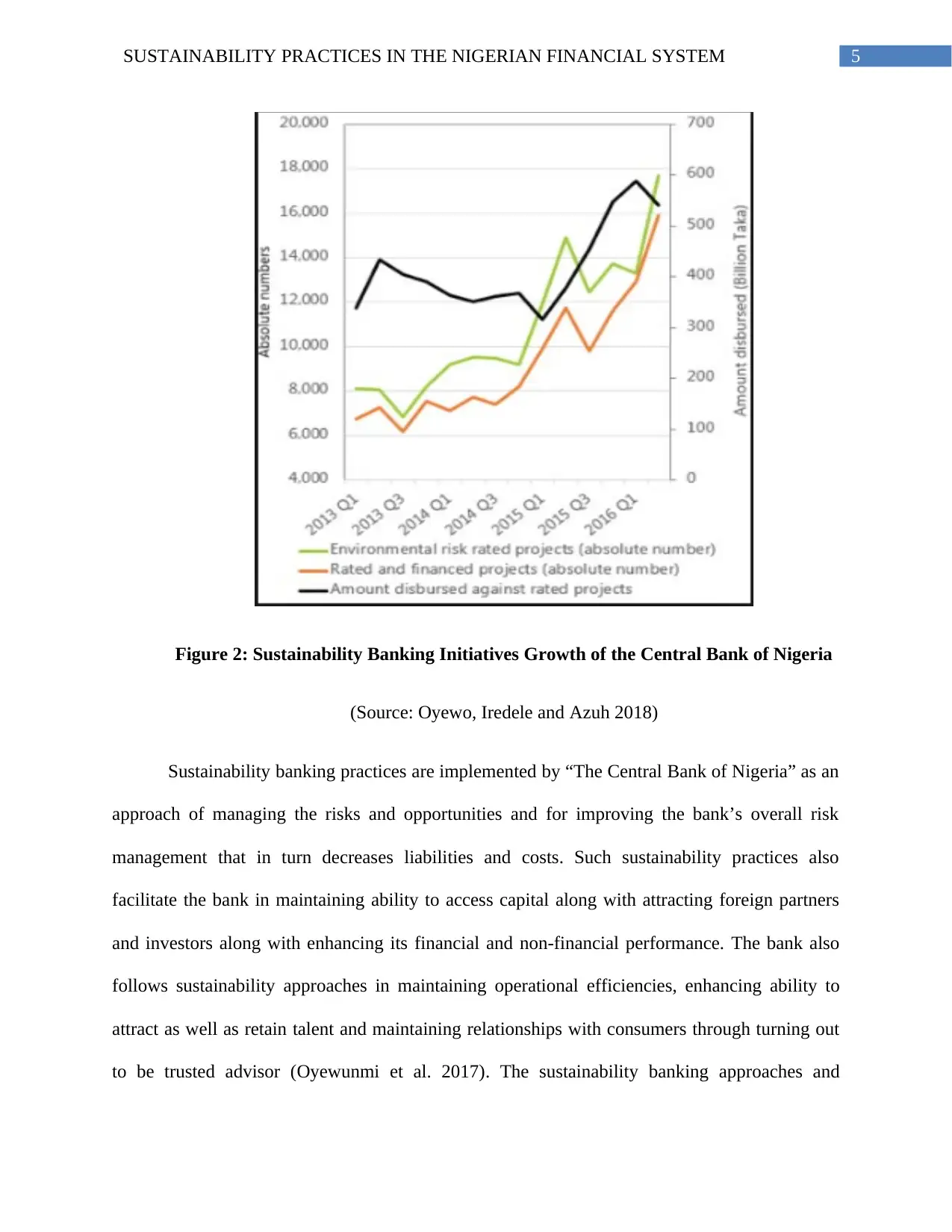
5SUSTAINABILITY PRACTICES IN THE NIGERIAN FINANCIAL SYSTEM
Figure 2: Sustainability Banking Initiatives Growth of the Central Bank of Nigeria
(Source: Oyewo, Iredele and Azuh 2018)
Sustainability banking practices are implemented by “The Central Bank of Nigeria” as an
approach of managing the risks and opportunities and for improving the bank’s overall risk
management that in turn decreases liabilities and costs. Such sustainability practices also
facilitate the bank in maintaining ability to access capital along with attracting foreign partners
and investors along with enhancing its financial and non-financial performance. The bank also
follows sustainability approaches in maintaining operational efficiencies, enhancing ability to
attract as well as retain talent and maintaining relationships with consumers through turning out
to be trusted advisor (Oyewunmi et al. 2017). The sustainability banking approaches and
Figure 2: Sustainability Banking Initiatives Growth of the Central Bank of Nigeria
(Source: Oyewo, Iredele and Azuh 2018)
Sustainability banking practices are implemented by “The Central Bank of Nigeria” as an
approach of managing the risks and opportunities and for improving the bank’s overall risk
management that in turn decreases liabilities and costs. Such sustainability practices also
facilitate the bank in maintaining ability to access capital along with attracting foreign partners
and investors along with enhancing its financial and non-financial performance. The bank also
follows sustainability approaches in maintaining operational efficiencies, enhancing ability to
attract as well as retain talent and maintaining relationships with consumers through turning out
to be trusted advisor (Oyewunmi et al. 2017). The sustainability banking approaches and
⊘ This is a preview!⊘
Do you want full access?
Subscribe today to unlock all pages.

Trusted by 1+ million students worldwide
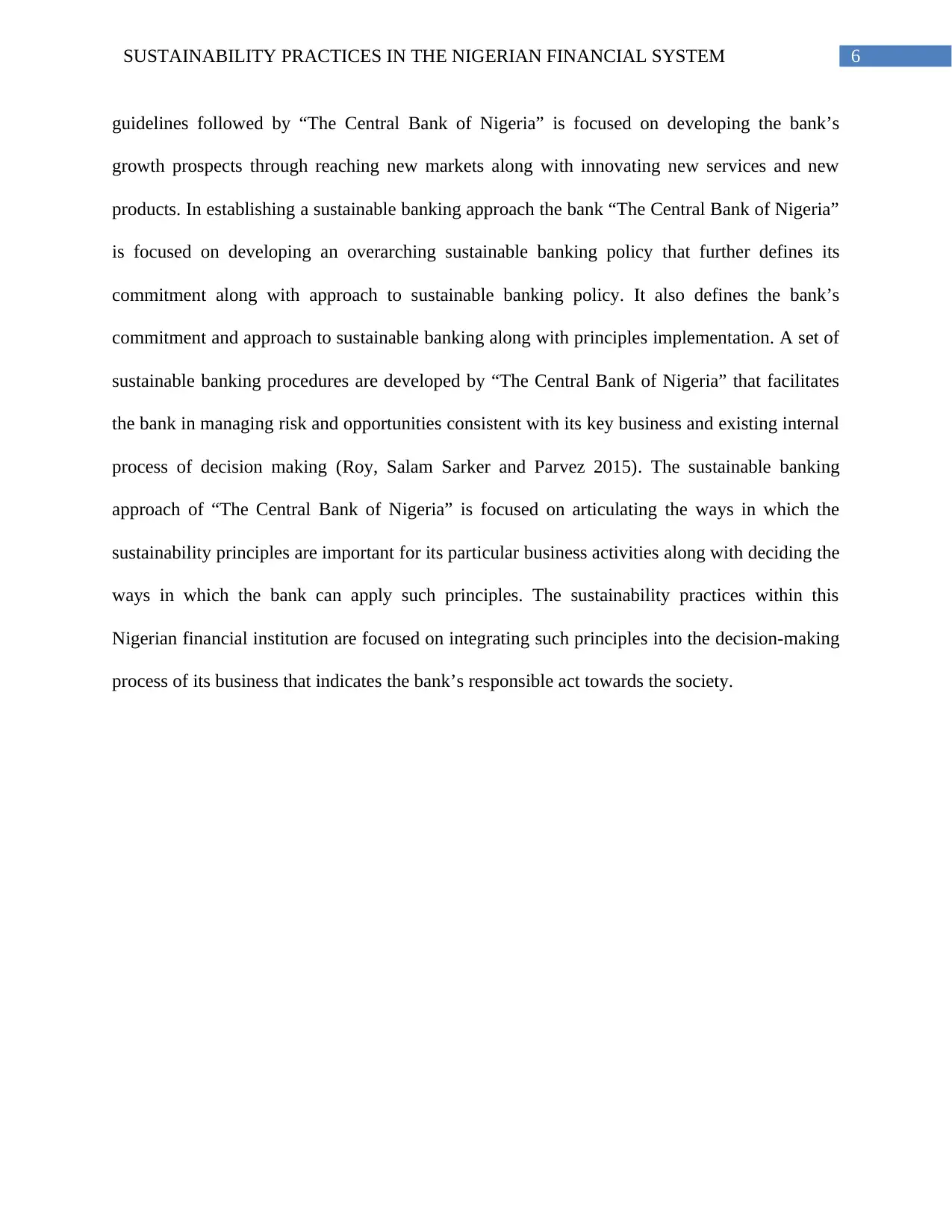
6SUSTAINABILITY PRACTICES IN THE NIGERIAN FINANCIAL SYSTEM
guidelines followed by “The Central Bank of Nigeria” is focused on developing the bank’s
growth prospects through reaching new markets along with innovating new services and new
products. In establishing a sustainable banking approach the bank “The Central Bank of Nigeria”
is focused on developing an overarching sustainable banking policy that further defines its
commitment along with approach to sustainable banking policy. It also defines the bank’s
commitment and approach to sustainable banking along with principles implementation. A set of
sustainable banking procedures are developed by “The Central Bank of Nigeria” that facilitates
the bank in managing risk and opportunities consistent with its key business and existing internal
process of decision making (Roy, Salam Sarker and Parvez 2015). The sustainable banking
approach of “The Central Bank of Nigeria” is focused on articulating the ways in which the
sustainability principles are important for its particular business activities along with deciding the
ways in which the bank can apply such principles. The sustainability practices within this
Nigerian financial institution are focused on integrating such principles into the decision-making
process of its business that indicates the bank’s responsible act towards the society.
guidelines followed by “The Central Bank of Nigeria” is focused on developing the bank’s
growth prospects through reaching new markets along with innovating new services and new
products. In establishing a sustainable banking approach the bank “The Central Bank of Nigeria”
is focused on developing an overarching sustainable banking policy that further defines its
commitment along with approach to sustainable banking policy. It also defines the bank’s
commitment and approach to sustainable banking along with principles implementation. A set of
sustainable banking procedures are developed by “The Central Bank of Nigeria” that facilitates
the bank in managing risk and opportunities consistent with its key business and existing internal
process of decision making (Roy, Salam Sarker and Parvez 2015). The sustainable banking
approach of “The Central Bank of Nigeria” is focused on articulating the ways in which the
sustainability principles are important for its particular business activities along with deciding the
ways in which the bank can apply such principles. The sustainability practices within this
Nigerian financial institution are focused on integrating such principles into the decision-making
process of its business that indicates the bank’s responsible act towards the society.
Paraphrase This Document
Need a fresh take? Get an instant paraphrase of this document with our AI Paraphraser
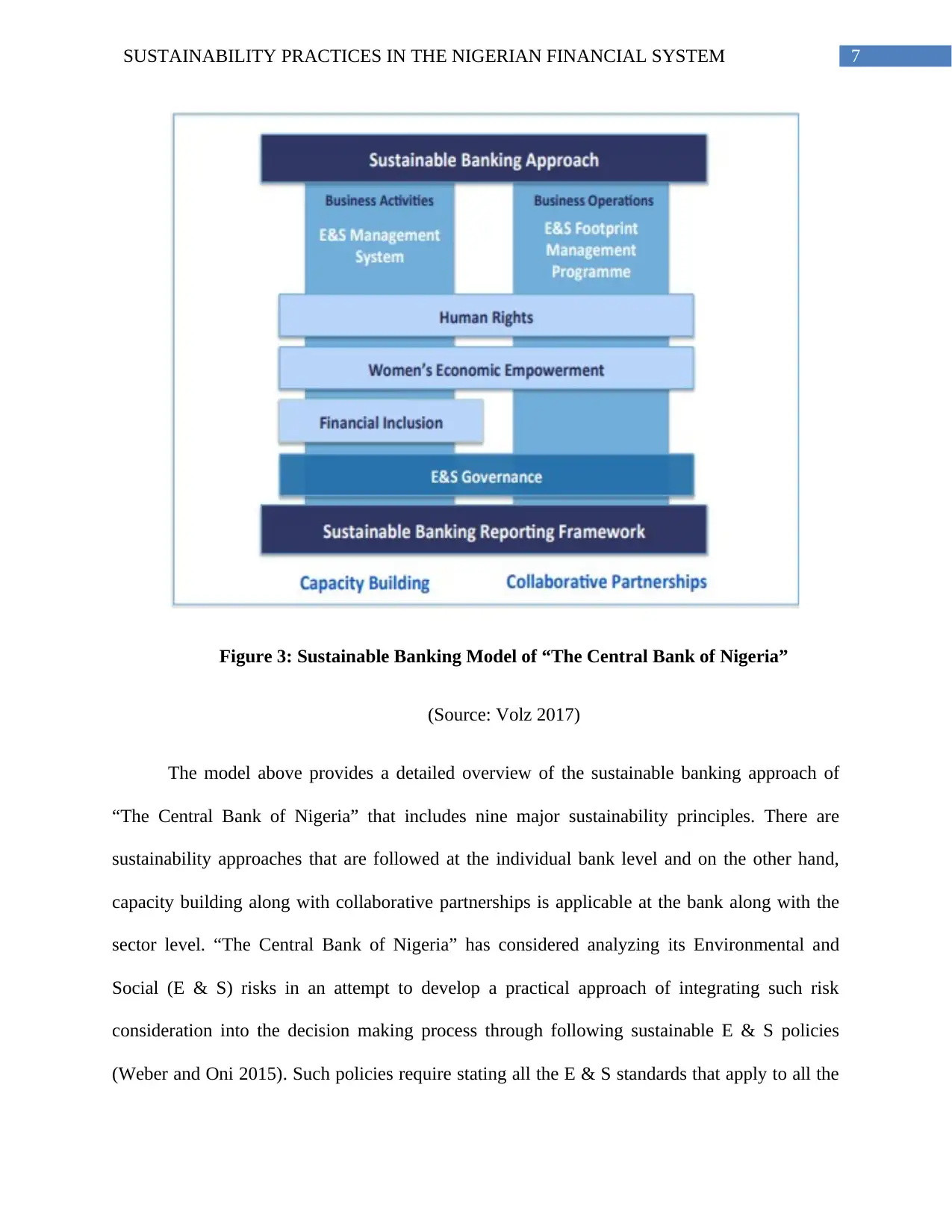
7SUSTAINABILITY PRACTICES IN THE NIGERIAN FINANCIAL SYSTEM
Figure 3: Sustainable Banking Model of “The Central Bank of Nigeria”
(Source: Volz 2017)
The model above provides a detailed overview of the sustainable banking approach of
“The Central Bank of Nigeria” that includes nine major sustainability principles. There are
sustainability approaches that are followed at the individual bank level and on the other hand,
capacity building along with collaborative partnerships is applicable at the bank along with the
sector level. “The Central Bank of Nigeria” has considered analyzing its Environmental and
Social (E & S) risks in an attempt to develop a practical approach of integrating such risk
consideration into the decision making process through following sustainable E & S policies
(Weber and Oni 2015). Such policies require stating all the E & S standards that apply to all the
Figure 3: Sustainable Banking Model of “The Central Bank of Nigeria”
(Source: Volz 2017)
The model above provides a detailed overview of the sustainable banking approach of
“The Central Bank of Nigeria” that includes nine major sustainability principles. There are
sustainability approaches that are followed at the individual bank level and on the other hand,
capacity building along with collaborative partnerships is applicable at the bank along with the
sector level. “The Central Bank of Nigeria” has considered analyzing its Environmental and
Social (E & S) risks in an attempt to develop a practical approach of integrating such risk
consideration into the decision making process through following sustainable E & S policies
(Weber and Oni 2015). Such policies require stating all the E & S standards that apply to all the
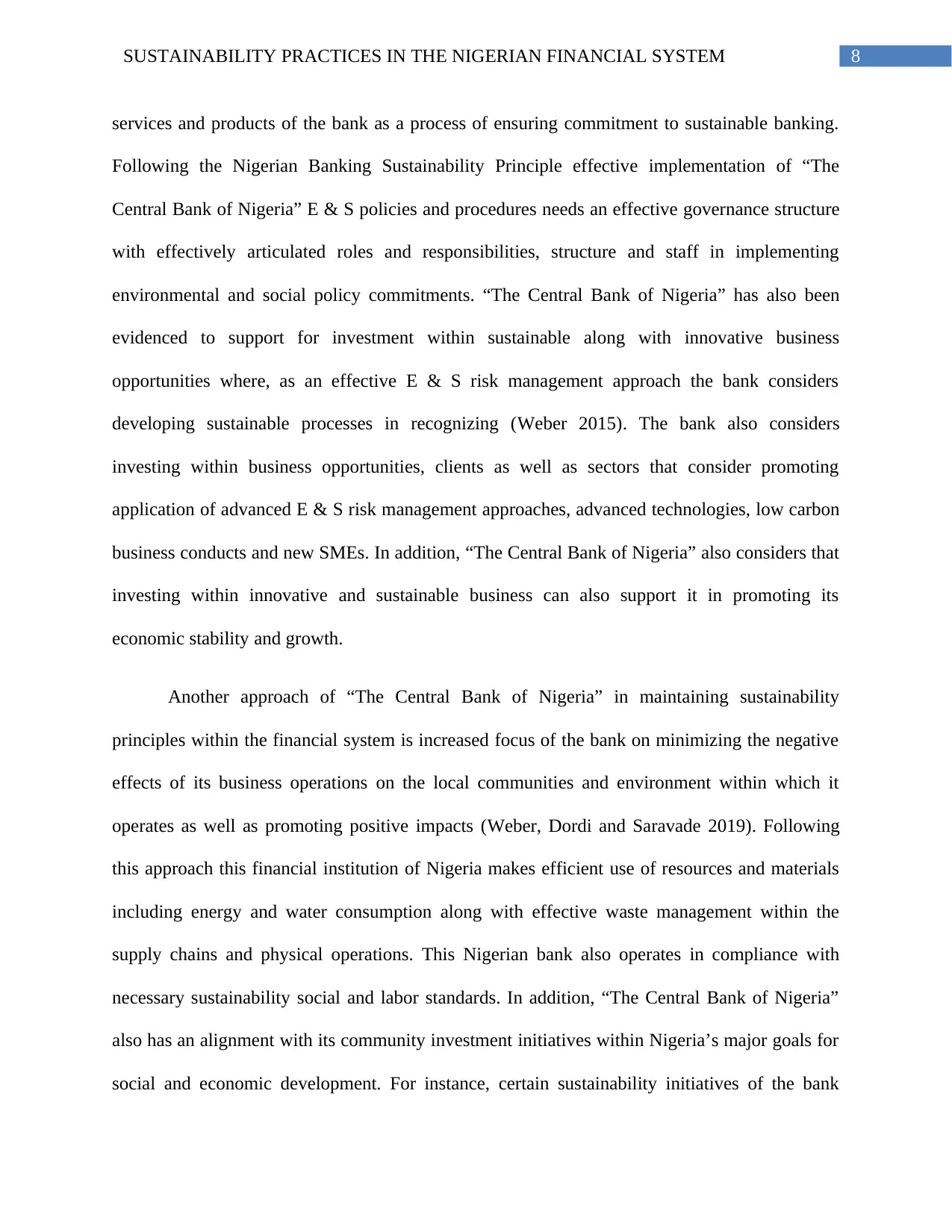
8SUSTAINABILITY PRACTICES IN THE NIGERIAN FINANCIAL SYSTEM
services and products of the bank as a process of ensuring commitment to sustainable banking.
Following the Nigerian Banking Sustainability Principle effective implementation of “The
Central Bank of Nigeria” E & S policies and procedures needs an effective governance structure
with effectively articulated roles and responsibilities, structure and staff in implementing
environmental and social policy commitments. “The Central Bank of Nigeria” has also been
evidenced to support for investment within sustainable along with innovative business
opportunities where, as an effective E & S risk management approach the bank considers
developing sustainable processes in recognizing (Weber 2015). The bank also considers
investing within business opportunities, clients as well as sectors that consider promoting
application of advanced E & S risk management approaches, advanced technologies, low carbon
business conducts and new SMEs. In addition, “The Central Bank of Nigeria” also considers that
investing within innovative and sustainable business can also support it in promoting its
economic stability and growth.
Another approach of “The Central Bank of Nigeria” in maintaining sustainability
principles within the financial system is increased focus of the bank on minimizing the negative
effects of its business operations on the local communities and environment within which it
operates as well as promoting positive impacts (Weber, Dordi and Saravade 2019). Following
this approach this financial institution of Nigeria makes efficient use of resources and materials
including energy and water consumption along with effective waste management within the
supply chains and physical operations. This Nigerian bank also operates in compliance with
necessary sustainability social and labor standards. In addition, “The Central Bank of Nigeria”
also has an alignment with its community investment initiatives within Nigeria’s major goals for
social and economic development. For instance, certain sustainability initiatives of the bank
services and products of the bank as a process of ensuring commitment to sustainable banking.
Following the Nigerian Banking Sustainability Principle effective implementation of “The
Central Bank of Nigeria” E & S policies and procedures needs an effective governance structure
with effectively articulated roles and responsibilities, structure and staff in implementing
environmental and social policy commitments. “The Central Bank of Nigeria” has also been
evidenced to support for investment within sustainable along with innovative business
opportunities where, as an effective E & S risk management approach the bank considers
developing sustainable processes in recognizing (Weber 2015). The bank also considers
investing within business opportunities, clients as well as sectors that consider promoting
application of advanced E & S risk management approaches, advanced technologies, low carbon
business conducts and new SMEs. In addition, “The Central Bank of Nigeria” also considers that
investing within innovative and sustainable business can also support it in promoting its
economic stability and growth.
Another approach of “The Central Bank of Nigeria” in maintaining sustainability
principles within the financial system is increased focus of the bank on minimizing the negative
effects of its business operations on the local communities and environment within which it
operates as well as promoting positive impacts (Weber, Dordi and Saravade 2019). Following
this approach this financial institution of Nigeria makes efficient use of resources and materials
including energy and water consumption along with effective waste management within the
supply chains and physical operations. This Nigerian bank also operates in compliance with
necessary sustainability social and labor standards. In addition, “The Central Bank of Nigeria”
also has an alignment with its community investment initiatives within Nigeria’s major goals for
social and economic development. For instance, certain sustainability initiatives of the bank
⊘ This is a preview!⊘
Do you want full access?
Subscribe today to unlock all pages.

Trusted by 1+ million students worldwide
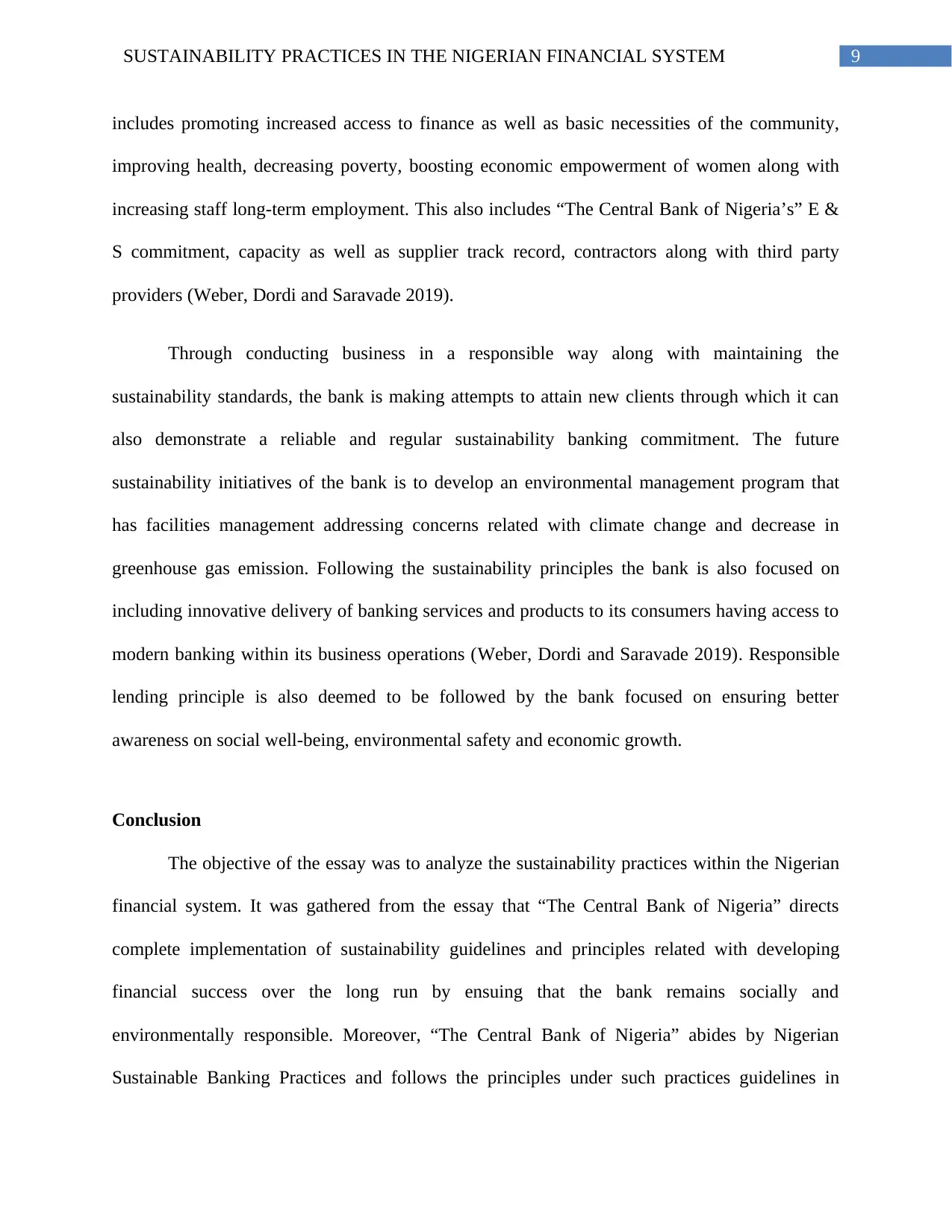
9SUSTAINABILITY PRACTICES IN THE NIGERIAN FINANCIAL SYSTEM
includes promoting increased access to finance as well as basic necessities of the community,
improving health, decreasing poverty, boosting economic empowerment of women along with
increasing staff long-term employment. This also includes “The Central Bank of Nigeria’s” E &
S commitment, capacity as well as supplier track record, contractors along with third party
providers (Weber, Dordi and Saravade 2019).
Through conducting business in a responsible way along with maintaining the
sustainability standards, the bank is making attempts to attain new clients through which it can
also demonstrate a reliable and regular sustainability banking commitment. The future
sustainability initiatives of the bank is to develop an environmental management program that
has facilities management addressing concerns related with climate change and decrease in
greenhouse gas emission. Following the sustainability principles the bank is also focused on
including innovative delivery of banking services and products to its consumers having access to
modern banking within its business operations (Weber, Dordi and Saravade 2019). Responsible
lending principle is also deemed to be followed by the bank focused on ensuring better
awareness on social well-being, environmental safety and economic growth.
Conclusion
The objective of the essay was to analyze the sustainability practices within the Nigerian
financial system. It was gathered from the essay that “The Central Bank of Nigeria” directs
complete implementation of sustainability guidelines and principles related with developing
financial success over the long run by ensuing that the bank remains socially and
environmentally responsible. Moreover, “The Central Bank of Nigeria” abides by Nigerian
Sustainable Banking Practices and follows the principles under such practices guidelines in
includes promoting increased access to finance as well as basic necessities of the community,
improving health, decreasing poverty, boosting economic empowerment of women along with
increasing staff long-term employment. This also includes “The Central Bank of Nigeria’s” E &
S commitment, capacity as well as supplier track record, contractors along with third party
providers (Weber, Dordi and Saravade 2019).
Through conducting business in a responsible way along with maintaining the
sustainability standards, the bank is making attempts to attain new clients through which it can
also demonstrate a reliable and regular sustainability banking commitment. The future
sustainability initiatives of the bank is to develop an environmental management program that
has facilities management addressing concerns related with climate change and decrease in
greenhouse gas emission. Following the sustainability principles the bank is also focused on
including innovative delivery of banking services and products to its consumers having access to
modern banking within its business operations (Weber, Dordi and Saravade 2019). Responsible
lending principle is also deemed to be followed by the bank focused on ensuring better
awareness on social well-being, environmental safety and economic growth.
Conclusion
The objective of the essay was to analyze the sustainability practices within the Nigerian
financial system. It was gathered from the essay that “The Central Bank of Nigeria” directs
complete implementation of sustainability guidelines and principles related with developing
financial success over the long run by ensuing that the bank remains socially and
environmentally responsible. Moreover, “The Central Bank of Nigeria” abides by Nigerian
Sustainable Banking Practices and follows the principles under such practices guidelines in
Paraphrase This Document
Need a fresh take? Get an instant paraphrase of this document with our AI Paraphraser
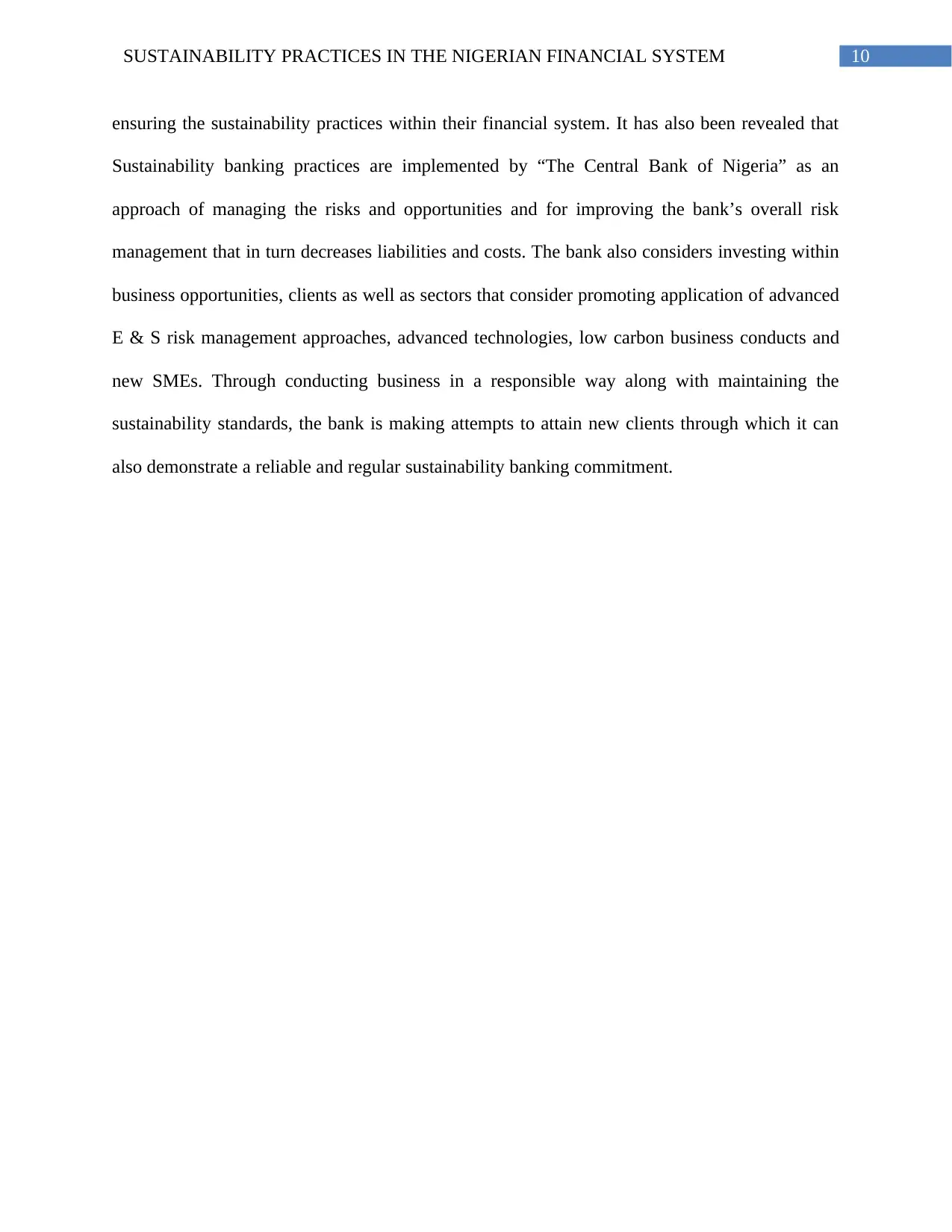
10SUSTAINABILITY PRACTICES IN THE NIGERIAN FINANCIAL SYSTEM
ensuring the sustainability practices within their financial system. It has also been revealed that
Sustainability banking practices are implemented by “The Central Bank of Nigeria” as an
approach of managing the risks and opportunities and for improving the bank’s overall risk
management that in turn decreases liabilities and costs. The bank also considers investing within
business opportunities, clients as well as sectors that consider promoting application of advanced
E & S risk management approaches, advanced technologies, low carbon business conducts and
new SMEs. Through conducting business in a responsible way along with maintaining the
sustainability standards, the bank is making attempts to attain new clients through which it can
also demonstrate a reliable and regular sustainability banking commitment.
ensuring the sustainability practices within their financial system. It has also been revealed that
Sustainability banking practices are implemented by “The Central Bank of Nigeria” as an
approach of managing the risks and opportunities and for improving the bank’s overall risk
management that in turn decreases liabilities and costs. The bank also considers investing within
business opportunities, clients as well as sectors that consider promoting application of advanced
E & S risk management approaches, advanced technologies, low carbon business conducts and
new SMEs. Through conducting business in a responsible way along with maintaining the
sustainability standards, the bank is making attempts to attain new clients through which it can
also demonstrate a reliable and regular sustainability banking commitment.
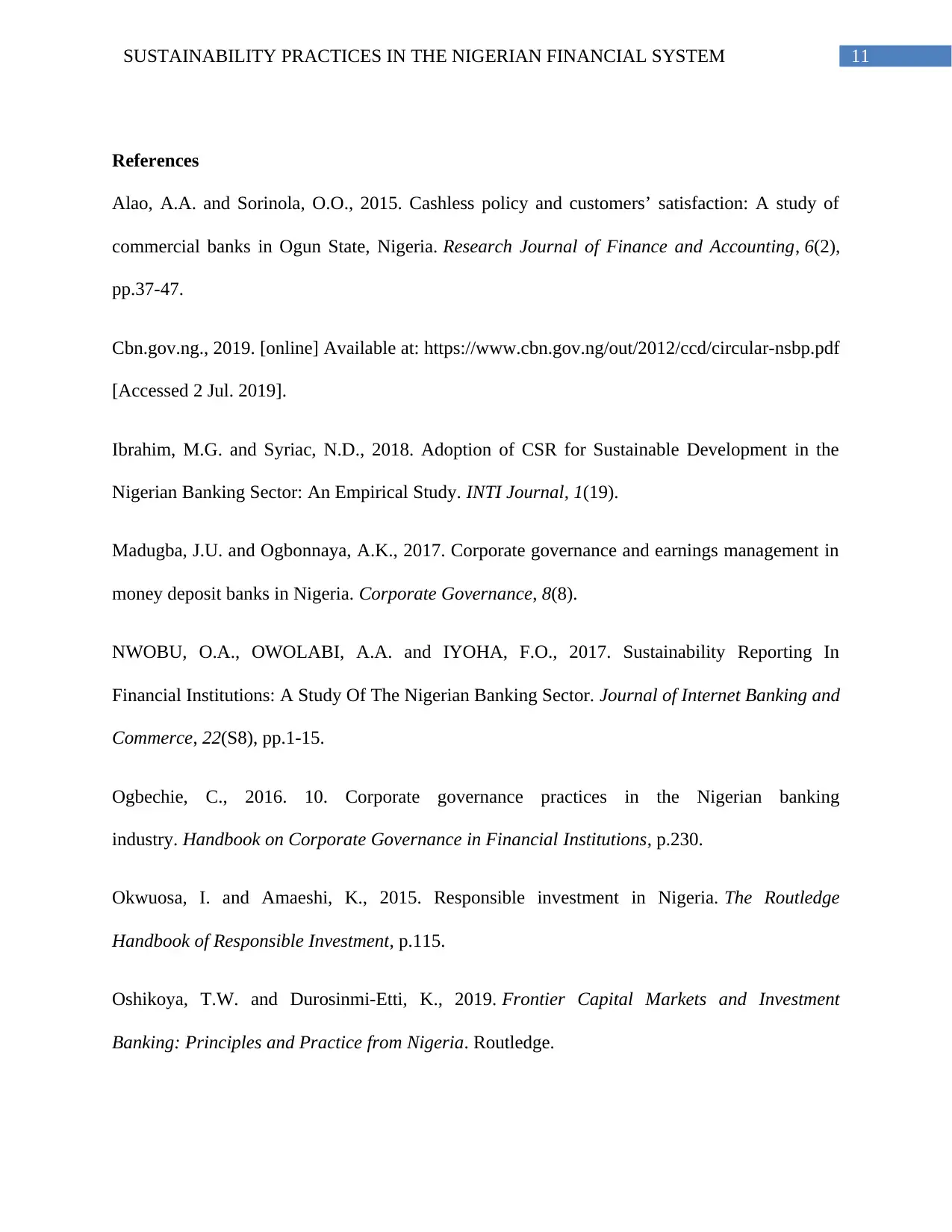
11SUSTAINABILITY PRACTICES IN THE NIGERIAN FINANCIAL SYSTEM
References
Alao, A.A. and Sorinola, O.O., 2015. Cashless policy and customers’ satisfaction: A study of
commercial banks in Ogun State, Nigeria. Research Journal of Finance and Accounting, 6(2),
pp.37-47.
Cbn.gov.ng., 2019. [online] Available at: https://www.cbn.gov.ng/out/2012/ccd/circular-nsbp.pdf
[Accessed 2 Jul. 2019].
Ibrahim, M.G. and Syriac, N.D., 2018. Adoption of CSR for Sustainable Development in the
Nigerian Banking Sector: An Empirical Study. INTI Journal, 1(19).
Madugba, J.U. and Ogbonnaya, A.K., 2017. Corporate governance and earnings management in
money deposit banks in Nigeria. Corporate Governance, 8(8).
NWOBU, O.A., OWOLABI, A.A. and IYOHA, F.O., 2017. Sustainability Reporting In
Financial Institutions: A Study Of The Nigerian Banking Sector. Journal of Internet Banking and
Commerce, 22(S8), pp.1-15.
Ogbechie, C., 2016. 10. Corporate governance practices in the Nigerian banking
industry. Handbook on Corporate Governance in Financial Institutions, p.230.
Okwuosa, I. and Amaeshi, K., 2015. Responsible investment in Nigeria. The Routledge
Handbook of Responsible Investment, p.115.
Oshikoya, T.W. and Durosinmi-Etti, K., 2019. Frontier Capital Markets and Investment
Banking: Principles and Practice from Nigeria. Routledge.
References
Alao, A.A. and Sorinola, O.O., 2015. Cashless policy and customers’ satisfaction: A study of
commercial banks in Ogun State, Nigeria. Research Journal of Finance and Accounting, 6(2),
pp.37-47.
Cbn.gov.ng., 2019. [online] Available at: https://www.cbn.gov.ng/out/2012/ccd/circular-nsbp.pdf
[Accessed 2 Jul. 2019].
Ibrahim, M.G. and Syriac, N.D., 2018. Adoption of CSR for Sustainable Development in the
Nigerian Banking Sector: An Empirical Study. INTI Journal, 1(19).
Madugba, J.U. and Ogbonnaya, A.K., 2017. Corporate governance and earnings management in
money deposit banks in Nigeria. Corporate Governance, 8(8).
NWOBU, O.A., OWOLABI, A.A. and IYOHA, F.O., 2017. Sustainability Reporting In
Financial Institutions: A Study Of The Nigerian Banking Sector. Journal of Internet Banking and
Commerce, 22(S8), pp.1-15.
Ogbechie, C., 2016. 10. Corporate governance practices in the Nigerian banking
industry. Handbook on Corporate Governance in Financial Institutions, p.230.
Okwuosa, I. and Amaeshi, K., 2015. Responsible investment in Nigeria. The Routledge
Handbook of Responsible Investment, p.115.
Oshikoya, T.W. and Durosinmi-Etti, K., 2019. Frontier Capital Markets and Investment
Banking: Principles and Practice from Nigeria. Routledge.
⊘ This is a preview!⊘
Do you want full access?
Subscribe today to unlock all pages.

Trusted by 1+ million students worldwide
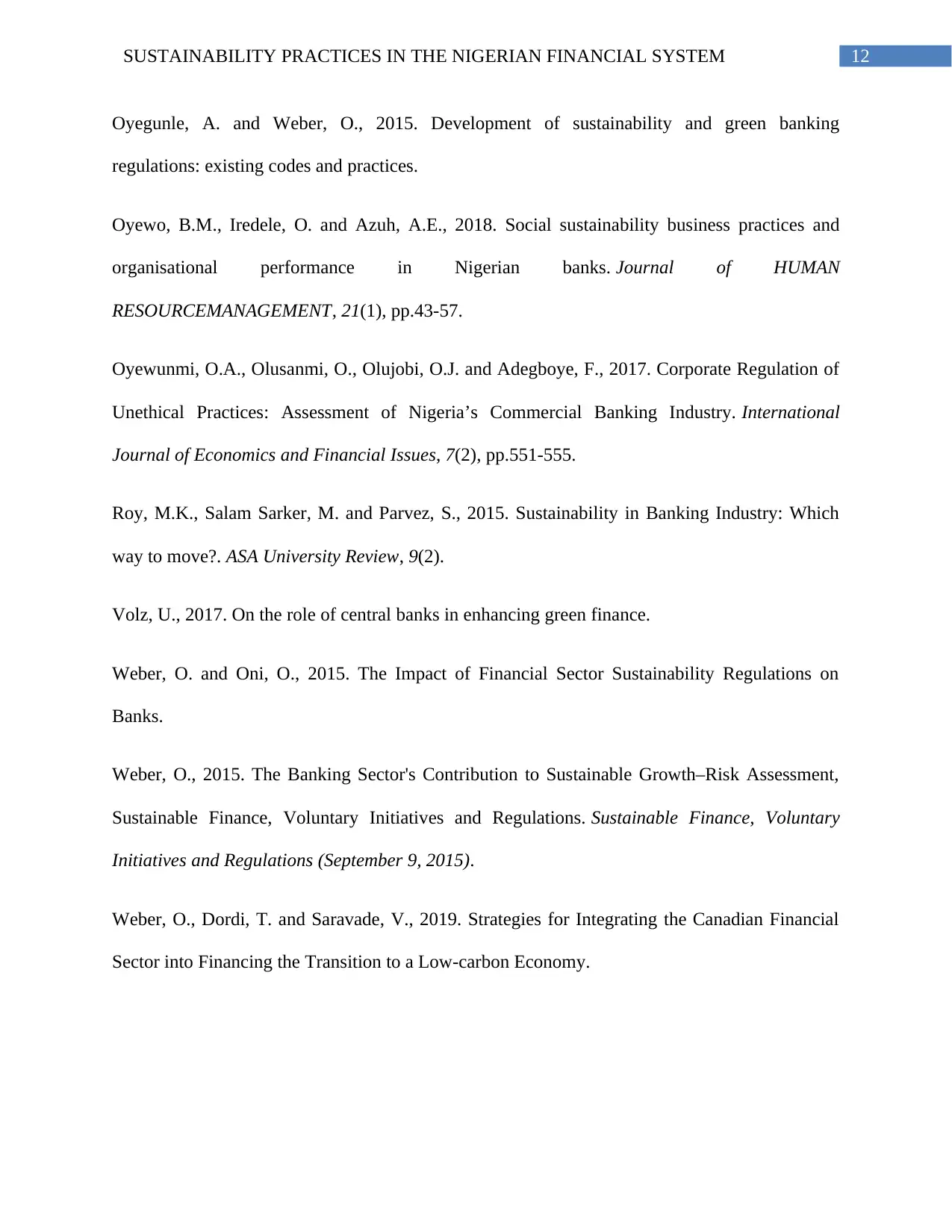
12SUSTAINABILITY PRACTICES IN THE NIGERIAN FINANCIAL SYSTEM
Oyegunle, A. and Weber, O., 2015. Development of sustainability and green banking
regulations: existing codes and practices.
Oyewo, B.M., Iredele, O. and Azuh, A.E., 2018. Social sustainability business practices and
organisational performance in Nigerian banks. Journal of HUMAN
RESOURCEMANAGEMENT, 21(1), pp.43-57.
Oyewunmi, O.A., Olusanmi, O., Olujobi, O.J. and Adegboye, F., 2017. Corporate Regulation of
Unethical Practices: Assessment of Nigeria’s Commercial Banking Industry. International
Journal of Economics and Financial Issues, 7(2), pp.551-555.
Roy, M.K., Salam Sarker, M. and Parvez, S., 2015. Sustainability in Banking Industry: Which
way to move?. ASA University Review, 9(2).
Volz, U., 2017. On the role of central banks in enhancing green finance.
Weber, O. and Oni, O., 2015. The Impact of Financial Sector Sustainability Regulations on
Banks.
Weber, O., 2015. The Banking Sector's Contribution to Sustainable Growth–Risk Assessment,
Sustainable Finance, Voluntary Initiatives and Regulations. Sustainable Finance, Voluntary
Initiatives and Regulations (September 9, 2015).
Weber, O., Dordi, T. and Saravade, V., 2019. Strategies for Integrating the Canadian Financial
Sector into Financing the Transition to a Low-carbon Economy.
Oyegunle, A. and Weber, O., 2015. Development of sustainability and green banking
regulations: existing codes and practices.
Oyewo, B.M., Iredele, O. and Azuh, A.E., 2018. Social sustainability business practices and
organisational performance in Nigerian banks. Journal of HUMAN
RESOURCEMANAGEMENT, 21(1), pp.43-57.
Oyewunmi, O.A., Olusanmi, O., Olujobi, O.J. and Adegboye, F., 2017. Corporate Regulation of
Unethical Practices: Assessment of Nigeria’s Commercial Banking Industry. International
Journal of Economics and Financial Issues, 7(2), pp.551-555.
Roy, M.K., Salam Sarker, M. and Parvez, S., 2015. Sustainability in Banking Industry: Which
way to move?. ASA University Review, 9(2).
Volz, U., 2017. On the role of central banks in enhancing green finance.
Weber, O. and Oni, O., 2015. The Impact of Financial Sector Sustainability Regulations on
Banks.
Weber, O., 2015. The Banking Sector's Contribution to Sustainable Growth–Risk Assessment,
Sustainable Finance, Voluntary Initiatives and Regulations. Sustainable Finance, Voluntary
Initiatives and Regulations (September 9, 2015).
Weber, O., Dordi, T. and Saravade, V., 2019. Strategies for Integrating the Canadian Financial
Sector into Financing the Transition to a Low-carbon Economy.
1 out of 13
Related Documents
Your All-in-One AI-Powered Toolkit for Academic Success.
+13062052269
info@desklib.com
Available 24*7 on WhatsApp / Email
![[object Object]](/_next/static/media/star-bottom.7253800d.svg)
Unlock your academic potential
© 2024 | Zucol Services PVT LTD | All rights reserved.





